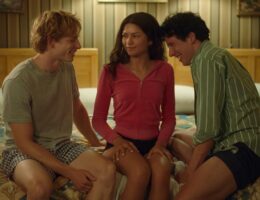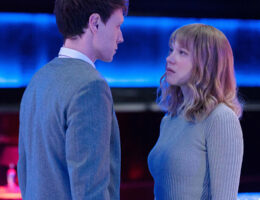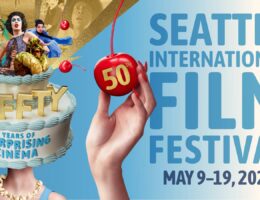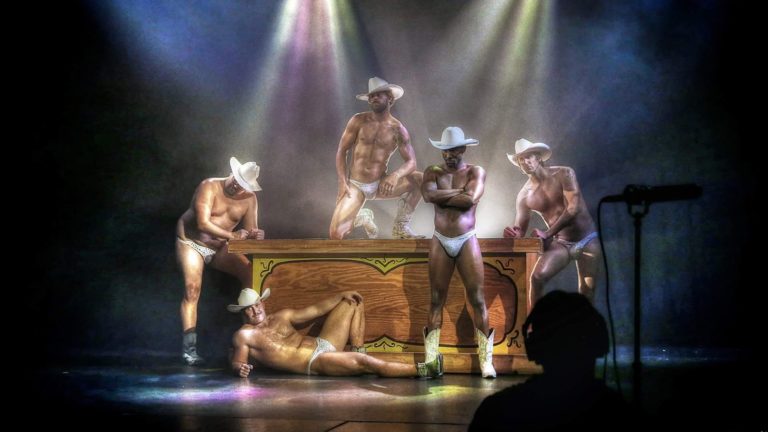The Long Haul is quite unlike any other documentary I’ve ever seen. It’s an engrossing look into “the Buckaroos,” the average Joe’s who had a run as strippers for a cabaret show at the Can Can Culinary Cabaret, in Pike Place Market. Billed as an “interactive documentary,” Seattle filmmaker Amy Enser goes deep into the joys and insecurities with a group of men who become unexpected (or expected?) sex symbols rather quickly.
Making its world premiere at the Seattle International Film Festival this week, The Long Haul is simply one of the most enjoyable movies to play this SIFF.
Amy Enser is a veteran of the Seattle film world, known as an editor, cinematographer, and director, The Long Haul is her first feature.
To learn more about this movie, and to understand why I enjoyed a movie (ostensibly) about male strippers so much, I met director Amy Enser and producer Sarah MacAaron for an interview.
Let’s talk about The Long Haul. How did the idea for making this film come about?
Amy Enser: I feel like I’ve told this story a thousand times.
But never to me…
It never gets old. So. I’ve been a filmmaker in Seattle for a long time, and I worked at a studio where I hired one of my closest friends, who is Jonathan Houser, who’s a DP in town. We worked together for years. He always has ideas for documentaries and he always pitches them to me first, which I am very flattered by. He thinks I’ll do service to them, or something. One day we were very busy. It was 2014, and he kept calling me up and saying, “Amy, I have this great idea for a documentary. It’s about me and these other guys. And we take our clothes off.” “What?” At the time, I said I do not have any time for what I considered an after-school project. It also sounded so ridiculous I didn’t know what to make of it, but he finally wore me down. He just was so insistent. “No, someone has to tell this story.”
So I showed up, and maybe I’m a little bit naïve at times. We had been working together for so long that they way he described it was as if he and I were going to do this project together. So when I finally showed up to our rehearsal, I showed up with my camera, guns blazing and walked into this tiny dance studio. It’s all steamy, and all these guys were not rehearsing. They were pumping iron, mostly naked, sweaty, whatever. And here I walk in. I have no idea who they are. We’ve never met before, and I’m rolling. I was uncomfortable in that awkward situation, I’m focusing on sweaty nipples or whatever. They don’t know me from Eve. But Houser was there, and I was intrigued, to say the least. I’m human. I thought, “this is interesting.”
I stuck around for a couple rehearsals, and just was charmed by the guys, pretty immediately, but again I thought it was going to be his and my project. Eventually he was like “Amy, why do you keep contacting me about information. Just contact Johnny,” who’s the lead of the troupe. He said, “For information. He’ll tell you. I got you into this project now it’s yours.” I sort of felt, like, well, I have already embarked on this. I guess I’m just going to do it. I really had no idea what that meant at first. So that first year I just showed up and filmed whatever and got to know them.
Last Halloween I did an interview with Chris Pink, of the Can Can, who is just great. And it was because the Can Can had two Halloween shows. They had the “Nightmare Before Christmas” one at Triple Door and then there’s “Zombie Cheerleaders from Hell.” One thing about it is that gender doesn’t matter there, it seems like. I’m just this really awkward, weird, introverted straight guy, and then there’s this hunky guy that starts serenading me at the show at Zombie Cheerleaders from Hell. It was uncomfortable, but also fun because the crowd was so into it and I wasn’t the first person to be singled out. I told my girlfriend that when I got home, and she asked “Was it just like all guys in the audience, then?” And I’m like “No, there were two bachelorette parties.” And she laughed and said “Oh, that’s hilarious.”
I don’t know how often you go to the Can Can, but kind of what came out of the Buckaroos, so the Buckaroos was their first, or actually their only, all-male show that they’ve ever done. It started in 2013 and sort of ended in 2017, unfortunately. But I think when they realized the appeal of that show, they started the Junkyard, which was a weekly late-night, late Thursday night, again, lo-fi male strip show that featured essentially the cast that was in the Buckaroos, so these average men. It gave them a chance to work out the kinks on stage, like get some practice time, be able to work with an audience. There was a little bit of that mentioned in the film. That ran for multiple years, and it was always sold out. Very quickly was sold out, and that’s where all the bachlorettes would go to, but couples would go to, gay men would go to. I mean, it was a ruckus good time because it’s essentially the Buckaroos, but where you can physically touch them because the proximity is so close.
And then we did a couple of shoots at Junkyard specifically for the film, and so I just packed the house with our people. So some of our male friends, just like you, actually got the courage to get up, because there’s a certain point in the show where it’s volunteers. You get to go up there and get oiled down and then parade down the catwalk. I mean, it really has been quite an empowering experience for just normal dudes. The audience goes wild for it. That was kind of accidental in the Buckaroos, in terms of casting. Johnny really wanted a regular, hunky strip show because Seattle didn’t really have their version of that, but they did.
So the scene that I recreated in the film of the audition is actually the original cast, the original judges, and the original way that they held auditions. I just recreated it authentically. But years ago in 2013 they did a live casting call as a show, and just brought in a bunch of audience members to help them decide who to cast. That is literally what happened, they brought this guy Joe, who is just their general contractor, on stage and he chopped wood and drank a beer in his underwear or whatever. And the women went nuts. Johnny and Chris, they were just scratching heads. They did not expect that. That is what led to them hiring all these normal guys.
I think that gets to what I enjoyed about this film, it seemed to have hit me at the time I needed it. My girlfriend and I, who I just mentioned, we actually just broke up last week. So I was like seeing this and thinking like, these guys are average Joes. They’re not like who you would see in a calendar of firefighters. They’re definitely better looking than me, but not like 100 times better. Maybe 10 times better…
Good, I’m so glad. Yeah, I’m really glad.
Amy’s done much of the talking so far, but can I ask how you got involved in the project, Sarah?
Sarah MacAaron: Well, Amy and I have collaborated since like 2011? Anyway, for a while. So it was similar to how she got involved with it, like “Hey, do you want to come and do this and film?” And we just started filming. We were working on another project at the time, and it was like “Hey, I’m filming. I need some help.” And then once we actually started doing the more staged stuff, like at the Can Can and at the Triple Door, and that kind of thing … I’m a producer as well as a production manager, so that was, for the most part, it was Amy and one other person out in the world filming on the fly. But then once we actually had more of a shoot pulled together that’s when we knew, “Okay, now we need a little bit more staff up here.”
Amy: And then I put together a grant video and started getting some funding. Okay, people are interested in this. I didn’t really know what I was going to do with it. There was interest, so I should take it seriously. 2015 and ’16 were my primary shoot years, and so I would grab my DP, and I asked people, “You want to help me with this? I have a little bit of money,” and I just filmed every day from their first production meeting all the way through the end of the summer in 2015.
Then I thought to really make this what I want to make it I have to shoot back at the Triple Door. I have to shoot at the Can Can. So I did a little bit of fundraising and that’s when we brought a full production crew, so like 20 person crew to do these quite massive re-stagings which you see in the film. The original idea for me is I wanted people in the audience to feel like they were watching a stage production. You know how those really quiet moments where you actually get to learn about the guys and kind of that accordion experience. I don’t know if I pulled that off.
And being at the Can Can is this really great place to see a show because it’s so small and so intimate. You’re just two feet away from people. The Triple Door is just not the same. I love the Triple Door, but it’s not. When I saw the juxtaposition last Halloween with the two different shows, and one of them was this big production. And that was awesome, and then there was the one the real stripped-down that was just pure lust from beginning to end in this little tiny place. It was great.
But, I think you really captured, especially opening with the narration and kind of opening the start of the show, not just beginning with them doing some random stuff or getting ready or whatever. It was like, okay, this is going to be the beginning of a show. I really liked how you opened that.
I actually developed the film originally as a hybrid live interactive documentary. Because I’m a documentary filmmaker, and I’m really interested in the medium of film and drawing attention to it. As a nonfiction storyteller I wanted to experiment with how a cinema audience engaged with nonfiction content differently if the subjects of the film were in there in person. What I did … I did that first, which is actually why the film has taken this long, because I actually finished a live show version in 2016, and as a preview screening TWIST commissioned me to put it on at their 2016 festival, and we sold out The Egyptian, also, but did it as a full two-stage managers, light effects, everything.
Some of those scenes in the film were actually performed live by the guys, by all the cast. Then we would do these moments where they would run through the audience, and we have fake paper money called Buck Bucks, and we have confetti cannons and squeaky ducks and whatever. You could stuff it in their panties and they would come through and sit in your lap and feed them your popcorn. So the narration by T-Bone was performed live, so he actually introduces the whole show and you get to know the characters through that. So it was this seamless, sometimes live, performance that would take over and the film would stop, or sometimes they would play simultaneously. It was a full two-hour show with a 10 minute intermission, just incredible.
We filmed the whole thing and got man-on-the-street testimonies. We also had a live interpreter because my film serves the hard of hearing community because the lead character’s parents are deaf. TWIST is a big supporter of the hard of hearing community, so we had two live interpreters, interpreted the entire film. Now I have closed captioning, which I’m very excited about for SIFF, so both screenings will have closed captions, which I’m really excited, so that community can come.
The goal initially was to package this up and take it on tour as a road show, but not in live stage theater venues, in cinemas. Because it really shook up what people’s expectations were about watching a movie, you know. It’s been three years now, or two-and-a-half years since I did that, and people still come up to me and talk to me about their experience. Those are the same people that are still going to come to this screening.
Now I realize though I’m not known outside the Northwest. I’m a professional editor, primarily, and people do know me for that. But as a director, I’m still working my way into the community. So outside the Northwest there were people that were interested in putting the show on but maybe didn’t know how to pay for it or how they would incorporate that into a festival because I really wanted to go to new media festivals and really shake that up. But I realized I needed to have the standalone movie, also. So I spent 2017 and ’18 finishing that, filming some of the stuff that I had done live and actually crafting it into a tighter, standalone movie.
What has been the reaction to people that you have shown this movie to so far?
For a grant fulfillment this past November, I had to show it to a small audience, and I used that as a testing ground to be like, okay, they won’t perform live, but what can we do to still get that same kind of energy? So I did. I just gave them rolls of this fake money. T-Bone came in sort of a half version of his character and introduced me to the crowd and then got volunteers to come down and shoot confetti at the end. It just created this energy. The audience, I swear, they behaved as if it was a full interactive show, even though the guys didn’t perform. They weren’t dressed up or anything. They were just in the audience.
That was really exciting to me to be like, okay, I can still capture that. I’m hoping that the screening here, back at The Egyptian, is my scalability test of a pared-down interactive experience. I want that. I feel like our culture in terms of theater-going is very singular. Maybe you go with a group of friends, but it’s a pretty individual experience, right. I want to create an experience where people are not afraid to interact with the screen and whoop and yell and clap when they feel like it.
Sarah: More and more of that concert-like, performance experience. I think that’s one of the things that’s been so exciting about seeing the evolution of the project over the years and coming into this really clear vision of these experimental qualities, the performance qualities. The cinema elements are great as well. All of that coming together where you still feel … I mean, I still feel excited seeing it. I think that speaks to not just your ability to manage all these elements together but also just the fact that the performers are so fantastic, too.
The subject matter is something that I feel like a lot of people can relate to as far as “What would it take for me to go up there and take my clothes off?” Also just the relevancy of the gender dynamics and stuff that we are all talking about these days as far as what is it to be masculine, feminine. “How am I defining myself in this world,” so there’s a lot there that I think people can grab onto and take away from the screening, even if it’s just a pared-down version. I don’t feel like it is. I feel like it’s just more refined so that it can scale.
And I was just thinking that I was aware that you did the screening a few years ago, and I was wondering how that evolved, but you already answered that. I remember covering TWIST, I think, and seeing that and said, “Oh, this sounds interesting,” but it’s also I don’t know if that’s my crowd. Either that or I couldn’t do it or something. But I was aware of it for a while, then when I saw your film is premiering at SIFF, I was bugging the publicists to set this interview up. “Okay, I really do want to talk to Amy about this movie because it sounds really interesting.” And it really was. I just, like I said, felt a lot better about myself watching it.
Sarah: That’s great. That’s so great. The idea of “I don’t know if this is my crowd.” I feel like this is one of those movies that is going to just make people curious. I’ve shared it with my friends, family, parents, anyone that you wouldn’t be like, okay, maybe you’re not going to go to a burlesque show, but it’s through this you have some distance with it. It allows you to open your mind a little bit around things that you may not have realized even about yourself, where you’re like “Hey.”
Amy: Well, it makes the marketing really tricky. I’ve done a few different tests, if you will, to try to capture different crowds, because it is tough. I mean, I think, it’s funny to be like “I made a male stripper movie,” but I didn’t really. That’s not how I would define it, but that’s how people see it at the outset, which is why someone like you would be like “I don’t think that’s my thing,” but what’s funny is that my accidental demographic has been straight men. I get more response from you, from people like you, over the years than anyone else. I mean, everyone loves it, but it really sticks to them because they can identify. They can relate, and I really feel like my movie is more of a buddy road trip movie, just that it takes place on stage.
Right. And I had this image in my head, and I’m sure you know what I’m talking about, with Chris Farley and Patrick Swayze on “Saturday Night Live,” which was a long time ago, but also something I found very mean, like the fat guy was the entire punchline. So this was the exact opposite, and really empowering.
Amy: I think that’s wonderful. That’s like the best response that I could get.
To get back to something you said earlier, this is maybe ostensibly a “male stripper movie” but it’s a lot more than that. I appreciated that you got to know these people. One scene that stuck with me was one of the Buckaroos saying how being a stripper like that would affect his relationships and jealousy would become a factor, especially when it happens so quickly.
Amy: I mean, the idea, hopefully, is that this isn’t a project that just because it’s about this specific performance group in Seattle, that it’s limited in scope to that, right. The idea is that the Buckaroos was just a catalyst or a backdrop for these guys to express themselves in a way that they weren’t expecting.
Sarah: Well, I was going to say I feel that the fact that the audience responds, especially with straight men, have been what it has been it accomplishes that goal because you can immediately identify. People feel like “Oh, well. Now, maybe, I feel like I can …”
Amy: I mean, people don’t expect that in this cast of characters, there’s only one gay man. They would expect that they’re mostly gay or whatever, and that’s just not the case, and we don’t even dive into that because it’s unnecessary. The idea is that it shouldn’t matter.
What’s going to happen after SIFF?
Amy: It’s the world premiere, and I have submitted to multiple festivals. I’m mostly trying to get out of the Northwest, and I want to see how the rest of the country, or the world, responds. It sounds like people are very interested. I’ve never done a feature before as a director, so this is definitely new. I’ve been contacted by other festivals where I’m being invited to submit. I’ve been contacted by some distributors and some sales agents and stuff like that. So we’ll see what happens.
My real goal with this film at this point is actually to support my next effort. I’ve been doing this one for so long I’m already in development for my next feature. I really just want people to see this. I don’t have any investors in the project, so I don’t owe anybody, which is wonderful. I really just want people to see it so I’m not in a rat race to make the most money. Whatever the best life for it is in terms of audience reach, that is my primary goal. I hope that that does that. As it moves around the country, I’d really like to take some of the guys with me to create some of that experience for the audience, which is always a treat. I mean, people fall in love with them so easily that having even one or two of them in person is just the best.
Do you have anything you can talk about regarding the world premiere?
So they’ll all be there … Well, unfortunately not all of them will be there at the same time for both screenings. I think Johnny is the only one that won’t be there on the premiere on Wednesday the 5th, but he will be there on Saturday the 8th. But then I think Kaleb will not be. We’ve got a life size cut-out of T-Bone that’s on stage.
I feel like there’s just so many ways to come at this movie, because it’s fun. You have people who are interested in gender, LGBTQ, or dance/performance. But I think, ultimately, people just have a really good time watching it, and that always is what people come back to with it. It’s something that makes you feel good. That’s really needed for a lot of people when they’re going to watch something. They want to walk away … “There’s a doc, and I walk away feeling happy about life, and it’s amazing.”
Last question, but is there anything you want to add while my tape recorder is still on?
Amy: I guess the last thing I want to contribute to this is that I find it really interesting being the only woman on this project, essentially. I mean not producer-wise, but…
But, I shot a lot of the film. It was just me and all of these men for most of this, a couple of years. And it’s just so fascinating to be a woman, like a wallflower in essentially what, to me, was a men’s locker room. It was a window into a world that you would never get access to, especially not every day, day after day, you know. I mean, I have literally seen it all. I have been in very close proximity to these people for years, and first of all, I’m like how did I get to do that? How was I the one that got to do that? Honestly, I think it’s just because I showed up. I just showed up, and they were like “Okay.”
Sarah: I think, yes, you showed up on day one, but the fact that it got to where it is today is straight up you finding that story, crafting it, making it what it is. And I think the fact that you are a woman gives a lot of people this access that I think not even the guys would have totally been … It took a lot to get some of this stuff out of them.
Amy: That’s true, and I hope that people see that. I hope that there’s a sensitivity to the film that was different because of a woman’s voice. I don’t know. I think about that, too, because I have no other experience than my own, so I don’t know how it would have changed if it would have been made by someone else or in a different way.
Sarah: You have a very unique perspective, and I feel like this definitely showcases a lot of those elements. If someone who’s seeing a collection of your work I’m like, yes, this highlights all the things of just a very unique point of view and bringing in your experimental work, bringing in your storytelling, bringing in all these elements. Including with getting this intimacy out of the guys is also another way for people to come into that story, along with all the song and dance and everything else.
Amy: I love the contradiction. I’m like, let’s glitz it up, and then tug on your heartstrings a little bit or surprise you. I’m glad that that is the case. I’m thrilled with the result. I love these guys, and I love this project, so I’m super happy that people are responding tell to it.
The Long Haul: The Story of the Buckaroos plays at the Seattle International Film Festival on Wednesday, June 5, at the Egyptian Theater at 7pm, and on Saturday, June 8, at SIFF Cinema Uptown at 11:00 AM. Tickets and more info can be found here.




